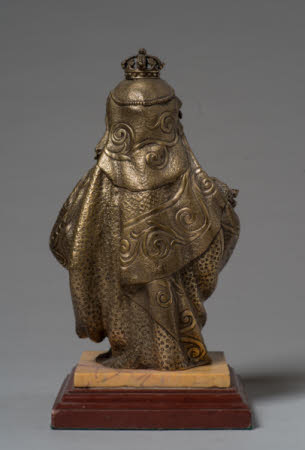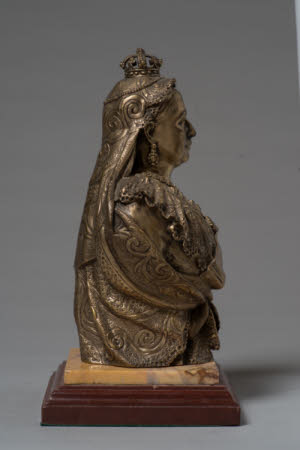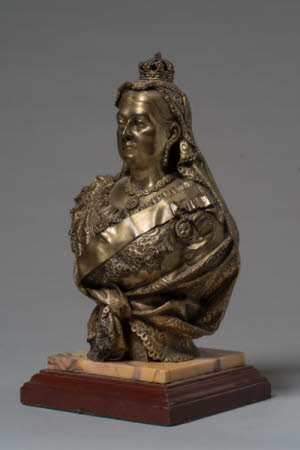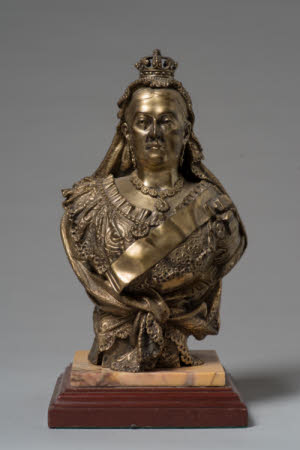Queen Victoria (1819-1901)
Antonio Pandiani (1838-1928)
Category
Art / Sculpture
Date
1890
Materials
Gilt-bronze
Measurements
226 mm (Height)
Place of origin
Milan
Order this imageCollection
Anglesey Abbey, Cambridgeshire
NT 515023
Summary
Gilt-bronze, portrait bust of Queen Victoria (1819-1901), modelled and cast by Antonio Pandiani (1838-1928) after Sir Joseph Edgar Boehm (1834-1890), 1890. A gilt-bronze bust-length portrait of Queen Victoria, made by Antonio Pandiani in 1890, after a well-known portrait of the queen by Sir Joseph Edgar Boehm. The portrait depicts the queen dressed formally in a dress with prominent scrolling pattern decoration, crowned and with a veil, decorated with similar scrolling vegetation, and heavily punched. Signed and dated on the small bronze base. Mounted on rectangular black and yellow marble base.
Full description
The small bust by the Milanese commercial art founder Antonio Pandani is loosely based on the images of Queen Victoria commissioned from Sir Joseph Edgar Boehm (1834-90), the Queen’s favourite portrait sculptor, in preparation for her Golden Jubilee in 1887. The principal statue was that commissioned from Boehm in 1885 for Sydney, intended to commemorate not only the Golden Jubilee, but also the centennial of New South Wales, unveiled in 1888 (Stocker 1988, pp. 105-08, cat. 281, pl. 95). Several derivations were made, including a full-length bronze statue of the queen for Castle Hill, Windsor, made in 1886-87 (Stocker 1988, pp. 108-09, cat. 295, pls. 97-98), of which there is a plaster bust-length version in the National Portrait Gallery (NPG 858). The Windsor statue was published in a commemorative volume for the queen’s Golden Jubilee (Holmes 1887, p. 45). It is very likely to have been from this or a similar published image that Pandiani drew his image of the monarch for his small bust. The dress and ornaments have been much simplified, in particular the rich patterned brocade of Queen Victoria’s dress in Boehm’s sculptures, already simplified in illustrations such as that in The Queen’s Pictures, has been transformed into a somewhat bizarre pattern with a band of large scrolling foliage contrasting with heavily punched patterns. Evidence that Pandiani had used a photograph comes from the back of the bust, where the dress and the veil seem entirely invented. The Milanese Pandiani dynasty included the notable Neo-classical sculptor Giovanni Pandiani (1809-1879), Costantino Pandiani (1837-1922) and Antonio Pandiani (1838-1928). Antonio studied at the Accademia di Brera and became a successful sculptor in the academic style, especially noted for his portraits, such as the bronze portrait of the writer Alessandro Manzoni of 1905, now in the Galleria d’Arte Moderna of Milan. Antonio seems to have provided many of the models for the bronze casts produced in the Pandiani foundry business, founded in 1821, and especially active during the period 1875-1910, when it cast works sculpted by various family members, who also included Adelaine, Agostino, Costantino, Giovanni and Innocente Pandiani. A typical example of Antonio’s work is the three-figure group Proud Father, in which the somewhat sentimentalised figures are chased with as much care as the bust of Queen Victoria (Berman 1974-1980, I, pp. 170-71, no. 720). According to Berman, ‘Milanese foundry work, of which this is an example, was of unsurpassed quality. Because production was limited, and of a specialized nature, Italian founders were never able to truly compete with the giants of Europe.’ Other works by Antonio include 'Resting' (Berman 1974-1980, II, p. 363, no. 1340), 'Art of Flirtation' (Berman 1974-1980, III, p. 581, no. 2127), 'Lion and Lioness', 'Cupid and Lion' and 'Barmaid’s Craft' (Berman 1974-1980, IV, pp. 936-37, nos. 3562, 3563, 3566). Portraits such as that of Queen Victoria appear to be rare in his surviving work, although he did also produce small bronze busts of Napoleon Buonaparte (example sold Mobili arredi ed oggetti d’arte, Casa d’Aste Pandolfini, Florence, 3 April 2012, lot 293) and of King Vittorio Emanuele II (dated 1881; Dipinti e Sculture del XIX secolo, Sotheby’s Milan, 19 December 2007, lot 126). The showrooms for the firm in its later years were at 17-19 via Brera, in Milan. To judge from an illustrated brochure published at the very end of Antonio’s life, in around 1927 (Ditta Antonio Pandiani, di Luigi Pandini [sic]. Bronzi d’arte, Ferri Battuti, Mobili, Antichità), the original foundry business had by then expanded to take on dealing in Old Master paintings and furniture, and the furnishing of rooms in various historicising styles, including Gothic, Louis XV and XVI, Venetian 18th-century, Pompeian and ‘Moresco’ style, with furniture designed by Carlo Bugatti (1856-1940). Another near-identical cast of this model was sold at auction by Mercier & Cie of Lille, Grande Vente catalogue d’art Classique, Lille, 3 May 2020, lot 293. Jeremy Warren 2020
Provenance
Bequeathed to the National Trust by Huttleston Rogers Broughton, 1st Lord Fairhaven (1896-1966) with the house and the rest of the contents.
Credit line
Anglesey Abbey, The Fairhaven Collection (The National Trust)
Marks and inscriptions
On left side of integral base:: A Pandiani/Milano/1890
Makers and roles
Antonio Pandiani (1838-1928), modeller after Sir Joseph Edgar Boehm, RA (Vienna 1834 - London 1890), sculptor
References
Christie, Manson & Woods 1971: The National Trust, Anglesey Abbey, Cambridge. Inventory: Furniture, Textiles, Porcelain, Bronzes, Sculpture and Garden Ornaments’, 1971, p. 132. Stocker 1988: Mark Stocker, Royalist and Realist: The Life and Work of Sir Joseph Edgar Boehm, Michigan 1988 Holmes 1887: Richard Holmes, The Queen’s Pictures, illustrating the Chief Events of Her Majesty’s Life (Magazine of Art Jubilee issue), London 1887 Berman 1974-1980: Harold Berman, Bronzes: Sculptors and Founders 1800-1930, 4 vols, Chicago 1974-1980








